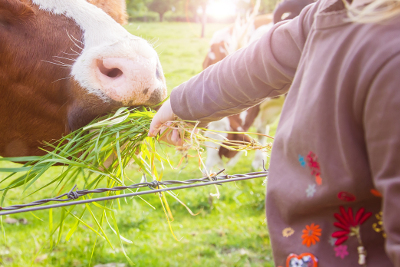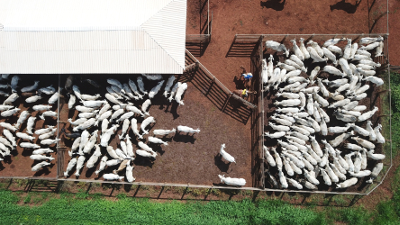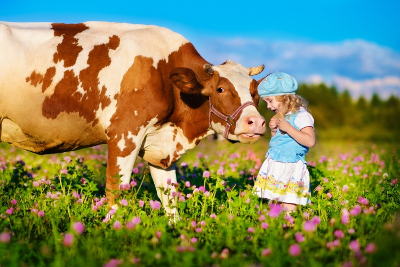


Sign-up for {N}power to get exclusive discounts, newsletters, members-only features, and more!
To our knowledge, no other grocery store, farmer's market or online retailer sells only 100% pasture-based dairy, except us. All the products in our dairy department come from animals that spend the entire grazing season out on managed pasture getting most of their nutrition and dietary intake from grazing on fresh growing grasses—they’re ruminants after all, and their health and happiness depend on fresh air, a bit of frolicking in the meadows and grassy vegetation.
 Our Pasture-Based Dairy Standards are beyond compare
Our Pasture-Based Dairy Standards are beyond compareAt its heart, our Pasture-based Dairy Standards mean that the animals' welfare is always top-of-mind, and they are provided with an environment that meets their needs and allows them to exhibit their natural behaviors, so they can live like the cows, goats, water buffalo, and sheep they are meant to be.
The main component of our Standards is that the animals must graze the entire grazing season. In addition to our grazing requirement, the following are some of the other important components of our Pasture-Based Dairy Standards:
Must have a pasture-management plan that addresses, soil, plant, air, and water quality
The grazing season must be at least 120 days long
Never given sub-therapeutic doses of antibiotics
Never fed animal by-products, plastic pellets, expired candy, expired baked goods, or sawdust
No growth promoters, including but not limited to antibiotics, hormones, coccidiostats (anti-parasitic drugs), and ionophores (non-therapeutic antibiotics that increase feed efficiency and are used to treat bloat and acidosis.)
Never given rBGH (recombinant Bovine Growth Hormone) or other synthetic milk production promoters/hormones, including estrogen
No cloned or genetically modified animals
No implanted embryos
No tail docking, wattling, or face branding
All animals must spend the non-grazing season outside unless severe weather prohibits it
No confinement of the animals is allowed, except for health reasons
If there is a non-grazing season where the farm is located, during this time, the animals must receive the majority of their dietary intake from dried forages
All animals must be treated humanely, nutritional needs must be met, and shelter must be provided as the environment dictates/requires
Cows and other ruminants belong on managed pastures, grazing, mooving, and grooving in the sun and doing what cows do best, regenerating grasslands that can sequester CO2 and help mitigate climate change.1 That's why we carry only 100% pasture-based products in our dairy departments. We believe pasture-based farming is better for the animals, the environment, and the economy. We also think you'll find that pasture-based dairy tastes udderly amazing and the nutrition benefits are hooves down the best.
For more details on the environmental benefits of pasture-based dairy, meander over here or take a gander at these books found in our book department: Cows Save the Planet and Water in Plain Sight, by Judith D. Schwartz.
In comparison to our Pasture-Based Standards, the majority of dairy products for sale in the US come from animals that spend the majority of their life confined inside a barn or a barren yard, in what is referred to as intensive production systems. In fact, 75% to 80% of all dairy cows in the US spend their artificially shortened lives in such systems.2
 They do not graze on fresh pasture, they do not frolic in the meadows. Studies show that the diet they eat drives inflammation and a variety of debilitating diseases, such as laminitis, and mastitis, which, in turn, drives the use of antibiotics and the proliferation of antibiotic-resistant bacteria.3,4 Additionally, studies indicate these types of dairy operations increase greenhouse gases, by using corn and soy-based feed and via the manure lagoons where the animal waste is collected.3,5,6 Both of these things also lead to poor air and water quality.3,5,6
They do not graze on fresh pasture, they do not frolic in the meadows. Studies show that the diet they eat drives inflammation and a variety of debilitating diseases, such as laminitis, and mastitis, which, in turn, drives the use of antibiotics and the proliferation of antibiotic-resistant bacteria.3,4 Additionally, studies indicate these types of dairy operations increase greenhouse gases, by using corn and soy-based feed and via the manure lagoons where the animal waste is collected.3,5,6 Both of these things also lead to poor air and water quality.3,5,6
Overall, studies also indicate that intensive dairy production systems are detrimental to the environment, harm animal health and wellbeing, damage the health and wellbeing of the communities located near them, compromise farmer and farm worker health, contribute to the escalating problem of antibiotic-resistant bacteria, have lower profitability than pasture-based operations, and drive environmental problems that compromise the future vitality of the economy.2,3,5,6,7
On the other hand, studies indicate that pasture-based dairy farms improve overall soil health, specifically, they increase soil carbon, increase earthworms, increase the water-holding capacity of the soil, and reduce soil erosion.8
Additionally, a report issued by The Union of Concerned Scientists found that raising cows on well-managed pastures provides significant environmental and other benefits, including decreased soil erosion and increased soil fertility, improved water quality (due to decreased pollution), improved human health (due to reduced antibiotic use), improved farmer and farm worker health, improved animal health and welfare and more profit per animal for producers.3
 Furthermore, according to multiple studies on the website www.eatwild.com: “When properly managed, raising animals on pasture instead of factory farms is a net benefit to the environment. To begin with, a diet of grazed grass requires much less fossil fuel than a feedlot diet of dried corn and soy. On pasture, grazing animals do their own fertilizing and harvesting. The ground is covered with greens all year round, so it does an excellent job of harvesting solar energy and holding onto topsoil and moisture. As you will read in the bulletins below, grazed pasture removes carbon dioxide from the atmosphere more effectively than any land use, including forestland and ungrazed prairie, helping to slow global warming.”5
Furthermore, according to multiple studies on the website www.eatwild.com: “When properly managed, raising animals on pasture instead of factory farms is a net benefit to the environment. To begin with, a diet of grazed grass requires much less fossil fuel than a feedlot diet of dried corn and soy. On pasture, grazing animals do their own fertilizing and harvesting. The ground is covered with greens all year round, so it does an excellent job of harvesting solar energy and holding onto topsoil and moisture. As you will read in the bulletins below, grazed pasture removes carbon dioxide from the atmosphere more effectively than any land use, including forestland and ungrazed prairie, helping to slow global warming.”5
Studies also indicate that pasture-based dairy products are better for you because they have a better ratio of omega 3 (inflammation-reducing)-to-omega 6 (inflammation-promoting) fats.3 They also contain higher levels of CLA (conjugated linoleic acid), a fatty acid that has been found to promote health,3 and higher levels of fat-soluble nutrients, such as vitamin A, carotenes, and vitamin E.5
At Natural Grocers, our standards are all about asking and achieving the what-ifs. That is why we created our Pasture-Based Dairy Standards in 2014 to help achieve these what-ifs. Our Dairy Standards make it possible to do good by eating good food. It means our dairy products are good4u, good for the animals, good for the environment, and, thus, good for the economy, the farmers, and the farm workers.9 And, we think they'll fill your heart with ever-lasting peace and contentment because they taste oh, so good, too!
We’ve been offering our communities certified organic dairy products since before the cows came home — which was in 2000 when the National Organic Standards were codified by the USDA. In fact, the majority of products in our Dairy Departments are certified organic. This means they meet our Pasture-Based Dairy Standards and are naturally non-GMO. It also means they are helping to regenerate our grasslands, sequester CO2, reverse climate change, and support our economic vitality into the future.10
Within our Pasture-Based Standards are a growing number of dairy products that are both 100% grass-fed and certified organic as well, including our Natural Grocers brand cheeses. 100% grass-fed, certified organic dairy is the cream of the crop, the best of the best, the crème de la crème when it comes to dairy.
1. Matsumoto, N. (2017, March 22). Why More Farmers Are Making The Switch To Grass-Fed Meat And Dairy. Retrieved from https://www.npr.org/sections/thesalt/2017/03/22/520015345/why-more-farmers-are-making-the-switch-to-grass-fed-meat-and-dairy
2. Agriculture. (2018, August 27). Retrieved from http://www.epa.gov/oecaagct/ag101/printdairy.html#dproduct
3. http://www.ucsusa.org/assets/documents/food_and_agriculture/greener-pastures.pdf
4. Agriculture. (2018, August 27). Retrieved from http://www.epa.gov/oecaagct/ag101/printdairy.html#11
5. Grassfarming Benefits the Environment. (n.d.). Retrieved from http://www.eatwild.com/environment.html
6. USDA ARS Online Magazine Vol. 59, No. 5. (n.d.). Retrieved from http://www.ars.usda.gov/is/AR/2011/may11/cows0511.htm
7. Lohan, T. (n.d.). Got Milk? A Disturbing Look at the Dairy Industry. Retrieved from http://www.alternet.org/story/145378/got_milk_a_disturbing_look_at_the_dairy_industry
8. Managed Grazing's Effects on Soil Quality and Structure. (n.d.). Retrieved from https://www.cias.wisc.edu/managed-grazings-effects-on-soil-quality-and-structure/
9. Replacing Grass With Trees May Release Carbon. (n.d.). Retrieved from http://www.ens-newswire.com/ens/aug2002/2002-08-08-07.html
10. USDA ARS Online Magazine Vol. 59, No. 3. (n.d.). Retrieved from https://agresearchmag.ars.usda.gov/2011/mar/soil



Sign-up for {N}power to get exclusive discounts, newsletters, members-only features, and more!